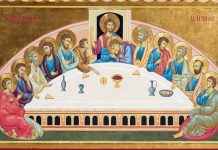
KEVIN CODY
Parents often think that the Sacraments are “things to get” for their children.
Catechetical leaders and catechists who prepare children for the Sacraments are familiar with this perspective from a significant number of parents, especially those whose children are preparing to receive First Communion and Confirmation. The motivation of these parents seems to be based on not wanting their children to miss out on what their friends are celebrating; approaching a sacrament as a rite of passage; or experiencing a sense of parental obligation.
We Have to Ask Ourselves…
Father William Bausch, author of A New Look at the Sacraments (Twenty-Third Publications), observes that “we have lost a sense of being church because our Sacraments have been reduced from grace-full actions to things.” Many parents lack an understanding of the value of the Sacraments in helping their children enter into relationship with the living God through Jesus by the power of the Holy Spirit.
As catechetical ministers, we have to ask ourselves: How well do we understand and value the Sacraments? How do we assist parents in understanding the true value of the Sacraments for their children and themselves, so that their families can become fully engaged in the life of Christ and his Church?
When I meet with parents who are registering their children for the first time in our religious education program, I ask: What do you want for your children by enrolling them in our parish program? Common answers include: “To learn about God” and “To give them a moral foundation.” We eventually get to their desire for their children to know God by entering into relationship with him.
When parents have difficulty expressing why they want their children to receive the Sacraments, we can lead them to an understanding of the Sacraments as a means to help their children physically encounter God; to enter into personal communion with him; and to receive sanctifying grace that will help them to lead moral Christian lives. This can be done in an informal manner through conversations, mailings, e-mails, and, in a more comprehensive manner, through parent formation workshops and retreats.
The Principle of Sacramentality
During the formation of parents prior to the Baptism of their children, we can help parents understand the principle of sacramentality, that is, how God uses the people and things of this world to communicate his presence and saving love. If parents have a good understanding of sacramentality and an appreciation for the Sacraments, it will be natural for them to begin the sacramental formation of their children before their children’s formal preparation begins in first grade.
Part of our objective would be to nurture in parents the perspective of (1) religious formation as a lifelong process of entering more deeply into the life, death, and Resurrection of Jesus, and (2) the Sacraments as ways to physically do this. Therefore, we want to assist parents in the religious formation of their children even during that period between their child’s Baptism and the child’s entry into the parish religious education program or Catholic school.
Perspectives of Sacramentality
Let’s take a brief look at some perspectives of sacramentality and their application to one of the Sacraments to generate ideas on what to consider when leading parents to an appreciation of the true value of the Sacraments.
Sacramentality is the belief that all material things speak to us of a dimension beyond the material. God’s presence is mediated into our lives through the material world. All reality, then, has the potential of being sacramental.
Material things that point to something beyond themselves are called signs and symbols. Very often symbols reach deep and stir memories and emotions that we find hard to express otherwise.
For example, I’ll ask parents if they are loved by someone. Then I’ll ask them how they know they are loved. They will mention expressions such as hugs, kisses, wedding bands, words, gifts, etc. The discussion then continues: Can you see love? If you can’t see love, then is it real? Do you doubt the reality of love?
We know that love exists through words, objects, gestures, and actions—signs of love. Love can be expressed only through signs. A kiss to a son or a daughter at bedtime is more than the act of pressing lips against a forehead or cheek. The act is a symbol with meaning that goes beyond words—and would be difficult to express in any other way. Love is made real through these expressions.
Parents want their children to believe in God, even if they have doubts themselves. They want to make God real for their children. They want help in leading their children to believe in someone they cannot see. Like love, the reality of God and Jesus must be made visible through words, gestures, signs, and actions.
There are many stories in the Bible about Jesus saying “I love you” while he was in the world. Jesus touches, feeds, cures, and helps people. Today, Jesus says “I love you” through the signs of his love, which we call Sacraments. When we explain to parents that the Sacraments make Jesus more real in our lives so that we can better enter into relationship with him, then the value of the Sacraments to them will resonate. Parents who have not had a solid formation in the Sacraments will first see the value for their children, then for themselves. So let’s apply this understanding to a Sacrament that their children will be celebrating.
Valuing Reconciliation
Reconciliation is the Sacrament most overlooked by parents. In my parish, First Reconciliation is celebrated in the same year as First Communion. When registering their child, parents are excited about their child’s First Communion, but some are not even aware that their child will be celebrating First Reconciliation as well. This is an indication of the low value these parents place on the Sacrament. So how do we use the principle of sacramentality to lead parents into valuing Reconciliation for their children?
We can start by acknowledging that even second-graders know that when they do something wrong, their relationships with others are affected. They remember how bad they feel when what they did hurt others or made others angry. They also know that saying they are sorry to parents, siblings, or friends makes those relationships better, and they are happier. What parent doesn’t want his or her child to be happy!
Next, we want to help parents relate their children’s need to say they are sorry and to receive forgiveness to their relationship with God. Children need to feel that God is not mad at them or hurt because of what they did. Their reconciliation with God leads to reconciliation with others. We acknowledge that their children can ask God for forgiveness anywhere and at any time.
But in the quiet of their bedrooms, can young children be confident that God hears them or truly forgives them? In the Sacrament of Reconciliation, with the understanding that the priest is a special servant of God, children hear God’s words of forgiveness. The invisible God is made visible, and his love and mercy are made real. Children can come away feeling better about themselves and their relationships. The experience nurtures within them a healthier perspective on life, enabling them to lead a happy life. This is what parents want for their children.
Let’s make every effort to lead parents into this understanding of the Sacraments as part of their children’s ongoing faith formation—which ultimately helps them lead their children toward a happy and healthy life in Christ.
Kevin J. Cody is the Director for Religious Education at St. Alphonsus Parish in Lemont, IL. He is the Midwest Representative and Vice-President of the National Association of Parish Catechetical Directors. He serves on the Archdiocese of Chicago Advisory Board and on the board of the Chicago Association of Religious Educators.
This article was originally published in Catechist magazine, December 2009.
Image Credit: Zolnierek/Shutter Stock 592148795




